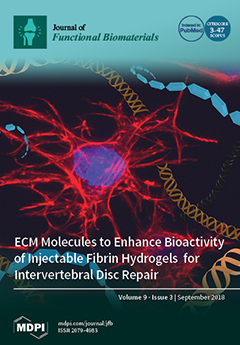The structural role of Germanium (Ge), when substituting for Zinc (Zn) up to 8 mol % in the 0.48SiO
2–0.12CaO–0.36ZnO–0.04MgO glass series, was investigated with respect to both the glass chemistry and also the properties of glass polyalkenoate cements (GPCs) manufactured from
[...] Read more.
The structural role of Germanium (Ge), when substituting for Zinc (Zn) up to 8 mol % in the 0.48SiO
2–0.12CaO–0.36ZnO–0.04MgO glass series, was investigated with respect to both the glass chemistry and also the properties of glass polyalkenoate cements (GPCs) manufactured from them. The Network connectivity (NC) of the glass was calculated to increase from 1.83 to 2.42 with the addition of GeO
2 (0–8 mol %). Differential thermal analysis (DTA) results confirmed an increase in the glass transition temperature (
Tg) of the glass series with GeO
2 content. X-ray photoelectron spectroscopy (XPS) showed an increase in the ratio of bridging oxygens (BO) to non-bridging oxygens (NBO) with the addition of GeO
2, supporting the NC and DTA results.
29Si magic angle spinning nuclear magnetic resonance spectroscopy (
29Si MAS-NMR) determined a chemical shift from −80.3 to −83.7 ppm as the GeO
2 concentration increased. These ionomeric glasses were subsequently used as the basic components in a series of GPCs by mixing them with aqueous polyacrylic acid (PAA). The handling properties of the GPCs resulting were evaluated with respect to the increasing concentration of GeO
2 in the glass phase. It was found that the working times of these GPCs increased from 3 to 15 min, while their setting times increased from 4 to 18 min, facilitating the injectability of the Zn/Mg-GPCs through a 16-gauge needle. These Ge-Zn/Mg-GPCs were found to be injectable up to 96% within 12 min. Zn/Mg-GPCs containing GeO
2 show promise as injectable cements for use in bone void filling.
Full article






